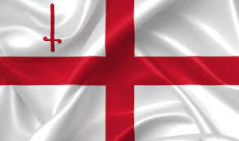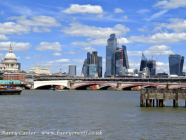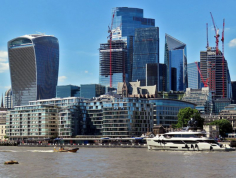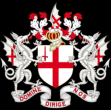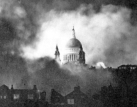





Docklands and the Thames,
Victoria Park to Paternoster
Square. Take a nostalgic
trip back to the East End in
the 1950’s or a stroll around
the Square Mile of the City
of London. It’s all here at
barryoneoff.co.uk
THE CITY of LONDON - A brief history
Copyright 2002 - 2024 ©Barry Carter. All rights reserved
The Square Mile
Greater London covers around 700 square miles. However, when we refer to the “City of London" we mean only the area that occupied the original old walled city built by the Romans. Founded during the first century it was the beginning of this great metropolis we know today.The old city covered an area of approximately one square mile and was surrounded by a six metre high wall and a ditch (or moat). The walls disappeared many years ago but this area is still referred to as “The Square Mile” or "The City". It has its own police force, separate from the Metropolitan Police. The coat of arms, top left, belongs to the City of London Corporation. This body, along with an annually elected Lord Mayor (not the Mayor of London), administrates everything within the square mile and is totally independent of any other national or London authority. It was founded centuries ago and apart from the Throne of England is the oldest governing body still in existence anywhere in the land. The City motto is: Domine dirige nos - Lord direct us. The City’s flag is the cross of St. George with a sword in the top left quarter. It represents the sword that killed Thomas Becket.City trivia spot
In an interview, Oscar Wilde once said: “To me the life of the businessman who eats his breakfast early in the morning, catches a train for the city, stays there in the dingy, dusty atmosphere of the commercial world, and goes back to his house in the evening, and after supper to sleep, is worse than the life of the galley slave. His chains are golden instead of iron”.Modern architecture
It was only after the exams to become an official City of London Guide that I started to see modern architecture in a different light. I began to realise that we have to move on. Old buildings that remain such as the medieval Great Hall of the Guildhall complex, ancient churches and of course Saint Pauls Cathedral are still magnificent but as the City was left almost totally destroyed after the war, something had to replace buildings that were beyond restoration and it had to be done quickly. Yes, mistakes were made and some of the post war constructions were hurriedly built to get the City back on its feet and working again. Today’s developments are well thought out and planned to help our ecology as well as aesthetics. Buildings such as the "Gherkin"are now more acceptable to people now. It is amazing how much trouble is taken when a new development is planned for the modern Square Mile to protect existing views. Every new commercial construction in the City now has to include a public space or garden in the plans. Roof gardens are created if there is little space below. The photo (left)shows the roof garden at 120 Fenchurch Street.The Lungs of The City
As well as present property developers having to provide an area for the public at their own expense, which the City maintains thereafter, there are already over 150 existing parks and open spaces in this relatively small area. All are maintained to a high standard by the City of London Corporation Open Spaces Department and are known as “the green lungs of the City”. Building plans sometimes have had to be altered simply to protect a London Plane tree or the view to St. Pauls from certain locations. This is how much the City Corporation tries to preserve what is left of its unique history.The Phoenix rising from
it’s own ashes
The Great Fire of 1666 destroyed 80% of The City. The tightly packed buildings with their jetties overhanging the lower floors almost touching the buildings opposite ensured that the fire would not be stopped before most were devoured by flames. Within a week after the fire Sir Christopher Wren produced plans for the complete rebuilding of the City based on a layout similar to the one he had seen on his only trip abroad to Paris. Six days to design a complete city! Did he have a part time job at Farryners, the bakers where it all started (only joking)! Wren's were not the only plans submitted and by the time discussions had gone on and finances debated, people had got impatient and started building their homes and businesses on the land they occupied before the fire. This is why, apart from a more recent developments, the City still follows the street plan that existed long before the 17th. Century. It was annoying for the planners but at least the City began to rise again from the ashes and trade could once more thrive. To settle any boundary disputes a panel of 22 judges was set up. These dealt only with matters arising from the rebuilding and they became known as the "Fire Judges". Christopher Wren's office was given the task of rebuilding 51 of the 88 churches destroyed in the fire, along with St. Pauls Cathedral, which incidentally, was totally destroyed when the wooden scaffolding used at the time for renovation work, caught fire. Wren was the man doing the repairs at the time! Almost three centuries later came World War II (1939-45) the City was almost totally destroyed again. 2,000 years of its history wiped out by two events. Once again, the building work was started and the City rose from its ashes for the second time (the third if you count the Iceni revolt of 60 AD.). The present day city now consists of metal and glass constructions which dwarf the few remaining historical buildings. Architects like Sir Terry Farrel, The Gilbert Scots, Norman Foster, Richard Rogers and others are the modern day equivalent of Sir Christopher Wren, Nicholas Hawksmoor and the George Dances. Wartime Gallery Below.